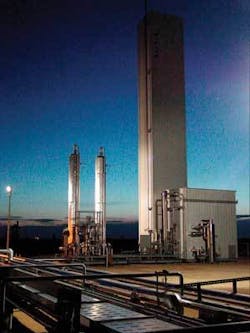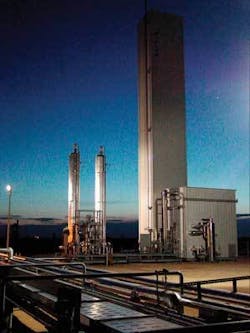N-removal technology improved to process West Texas Yates gas
Removing nitrogen from natural gas increases production potential and may spur drilling in the Yates formation, Permian basin.
Midland’s BCCK Engineering Inc. is building new nitrogen removal units in Texas and Oklahoma that will help capture the value of nitrogen-rich natural gas.
The company initially developed a low-volume nitrogen-removal process that was installed at the Mist gas field, northwestern Oregon in 1994 (OGJ, Mar. 13, 1995, p. 92).
BCCK’s Nitech process cryogenically separates nitrogen from methane in a single column, but does not employ a cryogenic pump or any rotating cryogenic equipment. The basic Nitech equipment includes a molecular-sieve gas dehydrator, regeneration gas heater, aluminum plate-fin heat exchanger, and a single distillation column with integral patented reflux condenser.
The company installed a Nitech system in Gaines County, Tex., in 2004. In April 2005, BCCK Engineering received the Hearst Energy Award for Technology in Midland for its improved Nitech process.
Beginnings
The introduction of the 10 MMcfd capacity nitrogen rejection unit (NRU) at the Mist gas field created salable gas from low btu natural gas containing 30-50% nitrogen. The Mist NRU was moved to Denver City, Tex., in 1996 and adapted to handle a different inlet stream, traditional gas containing 10-40% nitrogen.
In 2002, BCCK built a 24 MMcfd NRU in Grand Junction, Colo., to handle produced gas containing 15-50% nitrogen.
To date, NRUs have been installed at production facilities in nine states: Oregon, Texas, Colorado, Alabama, Kansas, Wyoming, California, North Dakota, and Oklahoma. BCCK’s original Nitech nitrogen removal process handles flow rates as low as 1 MMcfd and has been suitable for small fields.
The Nitech process is also used to remove natural gas liquids and helium, both of which can generate separate revenue streams. It’s suitable for capturing coal mine methane (CMM) and BCCK has installed CMM units in Pennsylvania, Alabama, and Illinois.
More recently, BCCK has implemented a new technology that enables the process to handle flow of 250 Mcfd or higher. The com-pany recently modified the reflux (knock-back) condenser so that it would be more efficient at higher inlet gas flow rates. The older design could recover 98-99% of the hydrocarbons; the new design recovers up to 99.9%, nearly 2% improvement. The new condensor was implemented in five NRU facilities in 2006.
The enhanced Nitech units are now being implemented in West Texas, enabling operators to produce natural gas from the shallow Yates reservoir, long ignored because its high nitrogen content prevented it from being accepted in regional pipelines.
West Texas
The Permian basin has historically been an oil province but strong prices for natural gas have inspired gas-focused drilling. The Yates formation is a natural gas reservoir with some condensate, found in northern Ector and Midland counties and running north through Gaines and Yoakum counties, Tex. The natural gas found in the Yates is often low-pressure, containing 15-20% nitrogen, causing it to be sold at a discount.1
Yates sediments are the product of cyclic marine flooding-dolomites, anhydrites, and halites-with a “regional trend of increasingly more open marine facies...to the south and west in the Permian basin.”1
Researchers at the University of Texas at Austin Bureau of Economic Geology assessed the Yates formation, particularly the Schaeffer Lake field in Andrews County. “Although the reservoir has a rather higher nitrogen content, there continues to be great interest in the production and sales of Yates gas.”2
Netherland, Sewell, & Associates Inc. studied the effect of the double displacement nitrogen injection process on enhanced oil recovery in Yates field. The project was subsequently converted to CO2 injection.3
In 2004, BCCK installed a nitrogen rejection plant in Gaines County, Tex., near Seminole, to process 5 MMcfd from the Yates formation for Dallas-based Lynx Operating Co. Inc. This turnkey project included system design, site work, procurement, and installation of the inlet gas dehydration system and the Nitech NRU, as well as installation of leased compression. The Nitech NRU and two 730-hp compressors successfully reduced nitrogen content in the produced gas to 4% from 20-30%, according to BCCK.
R. Clark Butts, BCCK president, said the Lynx facility took 24 weeks to develop from concept to production. “This will be a big benefit to the Permian basin. This [Yates] is a very prolific horizon that has been largely untapped in the Permian basin. It’s a shallow formation that exists in lots of areas.”4
The Yates formation has been identified in Lee County, NM, and in nine Texas counties. Butts told OGJ the “sweet spots” are in Yoakum, Ward, Gaines, Ector, Midland, and Andrews counties. Gas in the zone was ignored, he said, because of its high nitrogen content despite being tagged in about 2,000 well penetrations in Andrews County.5
More recently, BCCK designed two other nitrogen removal facilities in Texas, capable of processing 12 MMcfd and 50 MMcfd. The company is also building a 48 MMcfd CO2 removal facility in Oklahoma.
Construction of the 12 MMcfd facility, near Seminole, Tex., began in August 2006. It should be complete by end of first-quarter 2007.
BCCK designed the 50 MMcfd nitrogen rejection facilities in Madisonville, Madison County, Tex., for the Madisonville Gas Processing LP (which took over the assets of Hanover Compressor Co. in 2005). The new NRU facility is under construction parallel to an existing, less-efficient, 18 MMcfd facility built by AET in 2005.
The Madisonville NRU facility includes a mole sieve dehydration system, Modicon PLC control system, and facility engineering for ancillary equipment, including an amine unit used for removing CO2 prior to removing nitrogen. This conventional technology employs a blended MDEA (methyl diethyl amine) solvent that has an affinity for CO2 and H2S. It will begin operating this month.
Butts reviewed the new technology last year6 and will present a paper on nitrogen rejection in the technology development forum at the Gas Processors Association 86th annual convention, Mar. 11-14, 2007, in San Antonio.
References
- Combs, Deanna M., Kim, Eugene M., and Hovorka, Susan D., “Stratigraphic Characterization of the Yates Formation, Permian Basin, Texas,” West Texas Geological Society Fall Symposium, Midland, Oct. 8-9, 2003.
- “Regional Yates gas resource assessment and advanced reservoir characterization,” in Producer News, February 2002, Texas Region Petroleum Technology Transfer Council, www.energyconnect.com/pttc/newsletter/Feb2002newsletter.pdf
- www.netherlandsewell.com/tmn_enhan_rec.html
- “Strong prices and dwindling oil spur interest in Permian Basin resources,” Alexander’s Gas and Oil Connections, July 25, 2004, www.gasandoil.com
- Butts, R. Clark, “Permian Basin Low BTU Gas Processing,” paper presented at Gas Processors Association 85th Annual Convention, Mar. 5-8, 2006, Grapevine, Tex.
- Butts, R. Clark, “No more nitrogen,” Hydrocarbon Engineering, October 2006, www.hydrocarbonengineering.com.

